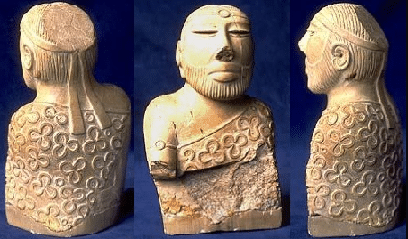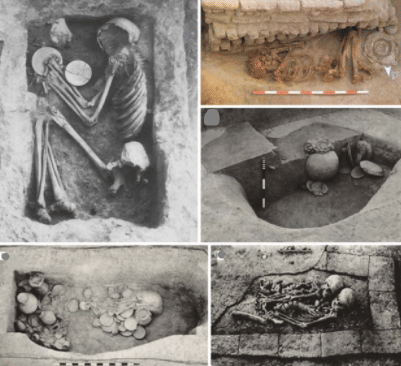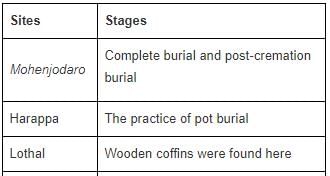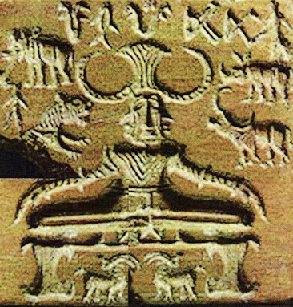Religion, Sculpture, Seals & Tools of the people at IVC - UPSC PDF Download
The idea of the religious practices of the people during IVC is given by the sculptures of that time. From the seals we interpret the knowledge of metrology and trade linkages of IVC with its contemporary civilizations.

The presence of script shows that the IVC had attained technological advancements and significant data was generated which was required to be written in script and recorded. The tools tells us not only the metals that were discovered at that time but also whether wars were common or not. Let us now study each of these aspects in detail.
Sculptures, Seals and Pottery
1. Sculptures
The discovery of statues, figurines of men and women in terracotta, stone and metal indicate that people of the area were great artists and sculptors.
➢ Terracotta Sculptures
- Terracotta refers to the use of fire baked clay for making sculptures.
- They were made using a pinching method and have been found mostly in the sites of Gujarat and Kalibangan.

- The most famous terracotta sculpture is that of the Mother Goddess found from Mohen-jo-daro. It is very detailed showing a punched nose, artistic ornamentation over the body and a fanned head gear. Terracotta sculptures were often crude and lacked finesse.
- These were the rarest type of sculptures found

➢ Stone Sculptures
- Stone sculpting was an advanced art in the IVC, which is clear from their polished surfaces and intricate designs.

Stone figure of a bull, Mohenjodaro
- The most commonly used stones where red and grey sandstone as well as steatite.
- There are two sculptures that are famous. A red sandstone figure of a naked male torso found in Harappa. It has separate sockets for the arms and legs.
The other sculpture made of grey sandstone is that of a bearded man wearing a trefoil patterned shawl, a fillet around the head and an amulet on the right arm. It is speculated that he was a Priest King or a wealthy merchant.

➢ Metal Sculptures
- The IVC people were well versed in the art of metal sculpting and created some sophisticated models. Bronze was used to cast such sculptures.
- A technique known as “Lost Wax Technique” or “cire-perdue” was used for this purpose.
- The most famous example for this is the bronze statue of the dancing girl from Mohen-jo-daro. This four inch figure depicts a naked girl with only ornaments, which includes the bangles in the left arm and amulet and bracelet on the right arm.

- She sports a necklace and her hair is tied into a bun. She is standing in the “tribhanga” dance posture.
- Besides the figurine, bronze figures of a buffalo and a humped bull were also found.

Bronze elephant
➢ Lost-Wax Technique
- In this technique, molten metal is poured into a mould that has been created by means of a wax model.
- The clay coated figures are then heated allowing the wax to melt.
- The wax is then poured out through a tiny hole and liquid metal is poured inside the hollow mould.
- After the metal has cooled down and solidified, the clay coat is removed and a metal figure of the same shape as the wax figure is obtained.

I. The most common type of sculptures was made out of terracotta.
II. IVC people used the pinching method to make stone sculptures.
III. The bronze statue of a dancing girl was discovered from Kalibhangan.
Choose the correct answer:
2. Seals
- Archaeologists have unearthed innumerable seals of various kinds from the IVC basin.
- The presence of different seals suggests the high standards of craftsmanship, knowledge of metrology, and flourishing trade and commerce.

- Seals were predominantly square-shaped although triangular, rectangular, circular, and cylindrical seals existed as well.
- A soft mineral stone called steatite was used to make the seals. Terracotta and copper were also used.
- Most seals had inscriptions in the local script as well as animal impressions on both sides.
- On an average, every seal had 5 symbols and were written right to left. Some of the seals have a knob at the back through which runs a hole.
- These seals could have been used by different guilds or merchants for stamping purposes.
Important Seals:-
(i) Pashupati Seal
It depicts a figure seated cross-legged in a yogic posture with a horned headdress.
(ii) Unicorn Seal
It depicts a mythological animal called a unicorn, which is a horse with a single horn on its forehead. It is the most frequently depicted animal in IVC seals.

(iii) Bull Seal
It shows a vigorous humped bull.
(i) Deer
(ii) Rhinoceros
(iii) Lion
(iv) Tiger
(v) Buffalo
(vi) Elephant
Significance of Seals
- The seals are believed to be used for sealing the consignment of goods and securing them by placing a mark of seal on the opening.
- Seals also served as identification of the trader.
- Seals with holes in them might have been used as amulets and were found in burial pits.
 Seals with holes
Seals with holes
- The symbols in the seals indicate the existence of a native script.
- The presence of mathematical images could also mean that they were also used for educational purposes.
- Generally, the seals had an animal or human figure on one side and an inscription on the opposite side or inscriptions on both sides.
- The presence of seals over a large expanse points to the fact that there was intense trade and commercial activities and the IVC economy wasn’t entirely agrarian.
- Some seals have the swastika symbol denoting some religious use as well.
- It also throws light on the socio-religious and other aspects of the culture.
3. Pottery
The IVC people were expert in the art of pottery and were very fond of it.
- The findings reveal a wide variety of wheel-made pots which show the consistent characteristics and standards of an organised manufacturing system.
- Early Harappan ware was more ceramic and later in the Mature phase, it evolved into a blend of ceramic styles from the regions west of Indus and beyond Saraswati rivers.
 Plain Ware
Plain Ware - Pots were of basically two types:
(i) Plain pottery was the more prevalent one and was made of red clay. They were used mainly for household purpose.
(ii) Painted pottery was the Red and Black pottery. Under such ware, red colour was used to paint the background and draw designs of animals, humans, geometric figures over it.

- Miniature vessels (less than ½ inch) were made for decorative purposes.
- Another unique pottery ware was the perforated jars which had a large hole at the bottom and small holes across the sides. Such jars were probably used to strain liquor.

Which of the following statement(s) is/are correct?
I. Mature Harappan pottery represents a blend of the ceramic tradition of the pre-Harappan culture of both West of the Indus region as well as of the Saraswati area.
II. The pottery technology was quite advanced and most of the pots were wheel-made.
III. Pots were beautifully painted in black on the bright red surface with geometric designs, plants, animals, and a few paintings seem to depict scenes from stories.
Religion, script, tools & Burial practices
1. Religion
- Excavations indicate that the IVC people had religious beliefs, which were more prevalent among the richer sections. The philosophy of the IVC religion is not known but enough evidence exist throwing light into the rituals and deities of the religion.
- However, religion did not hold a dominating sway over the daily lives of the masses.
- The chief male deity is thought to be Pashupati, considered to be a proto type of Shiva. He is depicted in numerous seals, mostly in a seated yogic position.The chief female deity was the Mother Goddess represented through terracotta figurines. She was also revered as the Goddess of Fertility.

- Fertility was also worshipped by the IVC people in the form phallic (linga) and yoni symbols.

- People considered certain trees such Peepal as sacred and were also practiced Animism, wherein animals or half-animals are worshipped.

- It is also possible that they believed in ghosts and spirits which can be inferred from the use of amulets.
- A seal discovered from Harappa depicts a naked woman with a tree coming out of her womb. This could be a reference to the Earth Goddess.
- They also practiced incense burning and yoga. The discovery of a large number of altars signifies a belief in ritualistic sacrifices.
- Further, it is probable that the IVC people believed in an after-life. This is clear from the practice of burying materialistic goods in pots in burial pits.
- Some Indus Valley seals show a swastika symbol, which is still used in all the Dharmic religions of the subcontinent.
- The existence of public baths suggests that people believed in ritual bathing.
2. Tools
- Tools were made out of bronze, copper, stone, bone or clay.

- These included agricultural implements, household tools, weapons and measuring instruments.
- Weapons were constructed from bronze and were largely of crude design. These were mostly arrow heads, bows, maces, axes, spears and knives, which were probably used for hunting.
- Interestingly, there has been no evidence yet of weapons of war from the IVC basin. Geographic insulation must have deemed such weapons as unnecessary.
- The IVC people developed a precise weighing and measurement system. The discovery of angle measuring instruments from Lothal site is proof of this.

- Their weights were usually made of lead.
- A copper scale was discovered in Harappa.
- They also developed several agricultural aids such as ploughs, mortars etc. A toy plough had been excavated from Banawali. Similarly, a wooden mortar was dug out in Harappa.
- Household items such as combs, mirrors, copper and bronze vessels, etc were also found across the basin. Several ivory combs, metal mirrors were found in Harappa and other sites.

(1) They possessed great palaces and temples.
(2) They worshipped both male and female deities.
(3) They employed horse-drawn chariots in warfare.
Select the correct statement/ statements using the codes given below.
I. Harappan tools included flat -axes, chisels, arrowhead, spearheads, knives, saws, razors, and fish-hooks. Which of the following statement(s) is/are correct?
II. Apart from tools people also made copper and bronze vessels.
III. Harappan people made small plates and weights of lead, and gold and silver jewellery of considerable sophistication.
3. Script
 The Indus script
The Indus script
- The numerous seals discovered give us the idea that the people had a language and a script of their own.
- The script is pictographic and more than four hundred signs have been identified. However, it still remains un-deciphered.

Ten signs found in Dholavira
- Typical Indus inscriptions are no more than four or five characters in length, most of which are very small.
- The characters are largely pictorial, but include many abstract signs, thus it is possibly a logo-syllabic script.
- The script was usually written right to left and sometimes followed the boustrophedon method of writing.
➢ Boustrophedon
- A type of bi-directional text, mostly seen in ancient manuscripts and other inscriptions.
- It literally means “ox-turning” in ancient Greek.
- In this system, alternate lines of writing are flipped.
- If the 1st line is read from right to left, then the 2nd line would be read from left to right and so on.
4. Burial Practices
- The IVC people practiced different forms to dispose of their dead.
- The most common method was cremation followed by burying the ashes. Such sites are found primarily in Sindh and Balochistan regions.
- Burial of the dead was the next significant method.

Pot burials, Lothal
- The placing of body in a foetal position is the hallmark of early phase of IVC.
- It is known that different regions and cities within the IVC practiced multiple burial practices.

- Pot burials were found from many sites in Gujarat such as Dholavira, Lothal, as well as from Cemetery in Harappa.
- In Lothal, an example of a double burial has been discovered.
- At Lothal, the burial pit was lined with burnt bricks indicating the use of coffins.
- A dog buried with human oval pit burials was discovered in Ropar, Punjab.
- The body of a man in a wooden coffin from Harappa was also excavated.
- In Kashmir’s Burzahom site, separate burial pits for dogs were discovered.
- The IVC people used large number of painted and plain pottery to store personal items of the dead and placed these in the burial pits next to the body.
- The mode of burial was non-uniform. Instances of primary burial as well as secondary burial (when the remains of the primary burial are exhumed and moved to another grave) were found.
Choose the correct option?
FAQs on Religion, Sculpture, Seals & Tools of the people at IVC - UPSC
| 1. What is the significance of religion in the Indus Valley Civilization? |  |
| 2. How did sculpture contribute to the culture of the Indus Valley Civilization? |  |
| 3. What can we learn from the seals of the Indus Valley Civilization? |  |
| 4. What were the tools commonly used by the people of the Indus Valley Civilization? |  |
| 5. How does the art of the Indus Valley Civilization compare to other ancient civilizations? |  |















